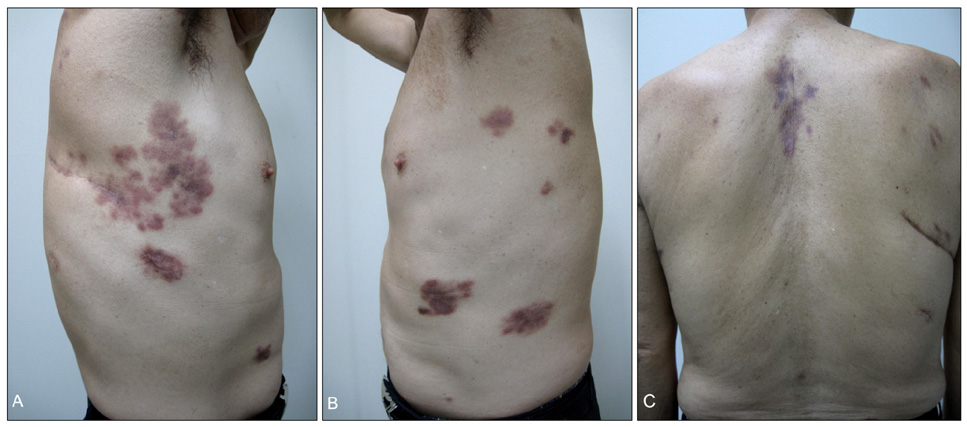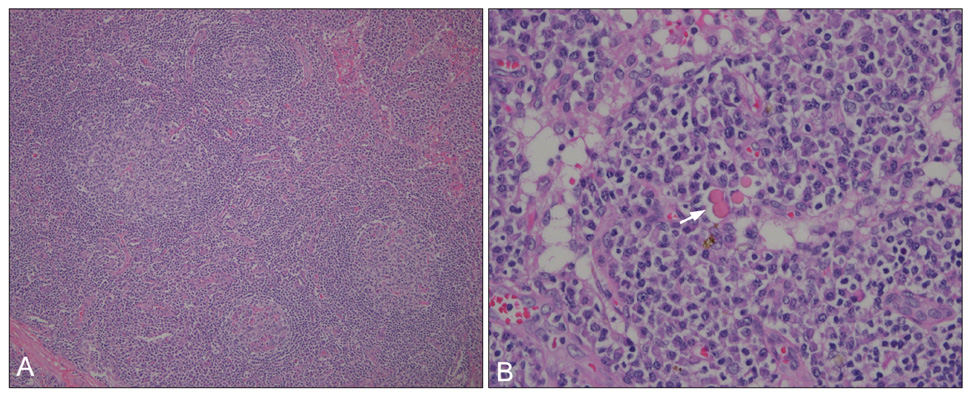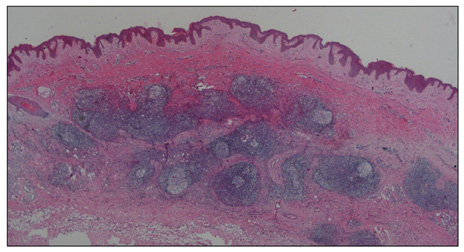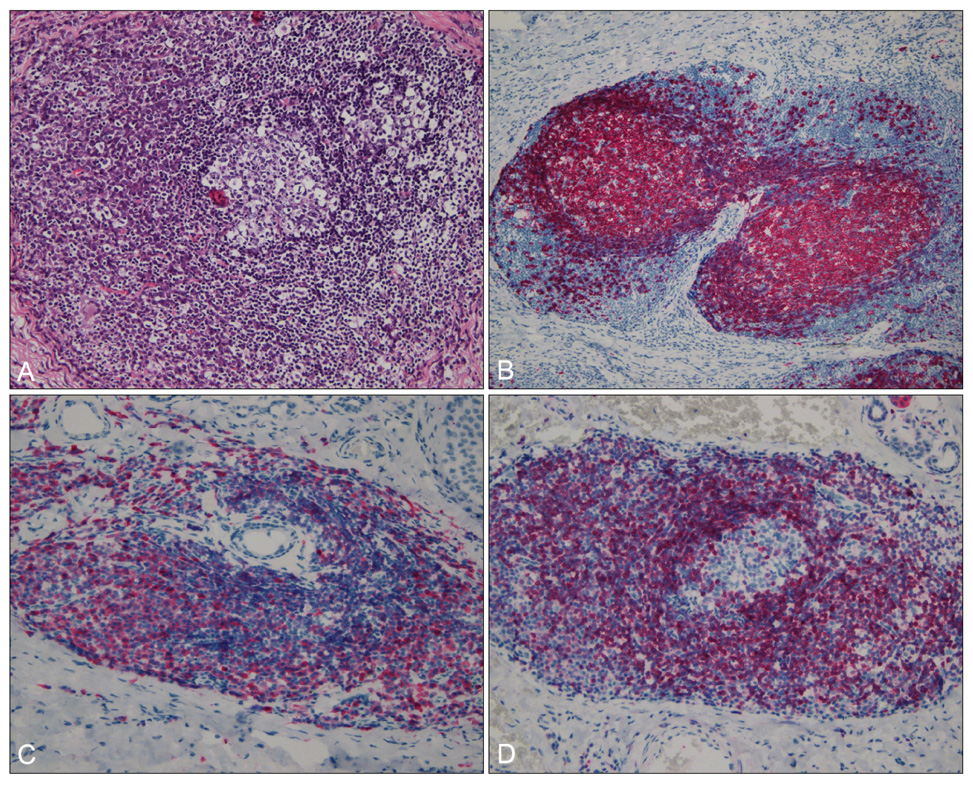Ann Dermatol.
2011 Oct;23(Suppl 2):S169-S174. 10.5021/ad.2011.23.S2.S169.
Castleman's Disease with Cutaneous Involvement Manifestating as Multiple Violaceous Plaques on Entire Body
- Affiliations
-
- 1Department of Dermatology, Chonnam National University Medical School, Gwangju, Korea. sjyun@chonnam.ac.kr
- 2Department of Hematology-Oncology, Chonnam National University Hwasun Hospital, Hwasun, Korea.
- KMID: 2156781
- DOI: http://doi.org/10.5021/ad.2011.23.S2.S169
Abstract
- Castleman's disease (CD) is an uncommon B-cell lymphoproliferative disorder characterized by lymph node hyperplasia with vascular proliferation. Cutaneous involvement in CD is rare. A 65-year-old man presented with a 7-year history of gradually developing multiple reddish to violaceous indurated plaques on the scalp, trunk, and legs. On physical examination, there were palpable enlarged cervical, axillary, and inguinal lymph nodes. Laboratory examination revealed anemia, thrombocytosis, hyperproteinemia, hypoalbuminemia, and polyclonal hypergammaglobulinemia. An inguinal lymph node biopsy and a skin biopsy were performed and the patient was diagnosed with the plasma cell type of CD. Chemotherapy was started and the lesions have responded to treatment.
Keyword
MeSH Terms
Figure
Reference
-
1. McCarthy MJ, Vukelja SJ, Banks PM, Weiss RB. Angiofollicular lymph node hyperplasia (Castleman's disease). Cancer Treat Rev. 1995. 21:291–310.
Article2. Keller AR, Hochholzer L, Castleman B. Hyaline-vascular and plasma-cell types of giant lymph node hyperplasia of the mediastinum and other locations. Cancer. 1972. 29:670–683.
Article3. Castleman B, Iverson L, Menendez VP. Localized mediastinal lymphnode hyperplasia resembling thymoma. Cancer. 1956. 9:822–830.
Article4. Chorzelski T, Hashimoto T, Maciejewska B, Amagai M, Anhalt GJ, Jablonska S. Paraneoplastic pemphigus associated with Castleman tumor, myasthenia gravis and bronchiolitis obliterans. J Am Acad Dermatol. 1999. 41:393–400.
Article5. Couch WD. Giant lymph node hyperplasia associated with thrombotic thrombocytopenic purpura. Am J Clin Pathol. 1980. 74:340–344.
Article6. Altiparmak MR, Pamuk GE, Pamuk ON, Doğusoy G. Secondary amyloidosis in Castleman's disease: review of the literature and report of a case. Ann Hematol. 2002. 81:336–339.
Article7. Liu W, Lacouture ME, Jiang J, Kraus M, Dickstein J, Soltani K, et al. KSHV/HHV8-associated primary cutaneous plasmablastic lymphoma in a patient with Castleman's disease and Kaposi's sarcoma. J Cutan Pathol. 2006. 33:Suppl 2. 46–51.
Article8. Kubota Y, Noto S, Takakuwa T, Tadokoro M, Mizoguchi M. Skin involvement in giant lymph node hyperplasia (Castleman's disease). J Am Acad Dermatol. 1993. 29:778–780.
Article9. Skelton HG, Smith KJ. Extranodal multicentric Castleman's disease with cutaneous involvement. Mod Pathol. 1998. 11:93–98.10. Klein WM, Rencic A, Munshi NC, Nousari CH. Multicentric plasma cell variant of Castleman's disease with cutaneous involvement. J Cutan Pathol. 2004. 31:448–452.
Article11. Kayasut K, Le Tourneau A, Rio B, Bost-Bezeaud F, Heuberger L, Diebold J, et al. Are multicentric Castleman's disease with cutaneous plasmacytosis and systemic plasmacytosis the same entity? Histopathology. 2006. 49:557–558.
Article12. Ahmed B, Tschen JA, Cohen PR, Zaki MH, Rady PL, Tyring SK, et al. Cutaneous castleman's disease responds to anti interleukin-6 treatment. Mol Cancer Ther. 2007. 6:2386–2390.
Article13. Okuyama R, Harigae H, Moriya T, Kagatani S, Tagami H, Ichinohasama R, et al. Indurated nodules and plaques showing a dense plasma cell infiltrate as a cutaneous manifestation of Castleman's disease. Br J Dermatol. 2007. 156:174–176.
Article14. Higashi Y, Kanekura T, Sakamoto R, Mochitomi Y, Kanzaki T. Multicentric Castleman disease with cutaneous manifestations: report of 2 cases and comparison with systemic plasmacytosis. Dermatology. 2007. 214:170–173.
Article15. Tomasini D, Zampatti C, Serio G. Castleman's disease with numerous mantle zone lymphocytes with clear cytoplasm involving the skin: case report. J Cutan Pathol. 2009. 36:887–891.
Article16. Sleater J, Mullins D. Subcutaneous Castleman's disease of the wrist. Am J Dermatopathol. 1995. 17:174–178.
Article17. Dham A, Peterson BA. Castleman disease. Curr Opin Hematol. 2007. 14:354–359.
Article18. Casper C. The aetiology and management of Castleman disease at 50 years: translating pathophysiology to patient care. Br J Haematol. 2005. 129:3–17.
Article19. Hirano T, Yasukawa K, Harada H, Taga T, Watanabe Y, Matsuda T, et al. Complementary DNA for a novel human interleukin (BSF-2) that induces B lymphocytes to produce immunoglobulin. Nature. 1986. 324:73–76.
Article20. Yoshizaki K, Matsuda T, Nishimoto N, Kuritani T, Taeho L, Aozasa K, et al. Pathogenic significance of interleukin-6 (IL-6/BSF-2) in Castleman's disease. Blood. 1989. 74:1360–1367.
Article21. Soulier J, Grollet L, Oksenhendler E, Cacoub P, Cazals-Hatem D, Babinet P, et al. Kaposi's sarcoma-associated herpesvirus-like DNA sequences in multicentric Castleman's disease. Blood. 1995. 86:1276–1280.
Article22. Gessain A, Sudaka A, Brière J, Fouchard N, Nicola MA, Rio B, et al. Kaposi sarcoma-associated herpes-like virus (human herpesvirus type 8) DNA sequences in multicentric Castleman's disease: is there any relevant association in non-human immunodeficiency virus-infected patients? Blood. 1996. 87:414–416.
Article23. Pavlidis NA, Briassoulis E, Klouvas G, Bai M. Is interferon-α an active agent in Castleman's disease? Ann Oncol. 1992. 3:85–86.24. Rieu P, Droz D, Gessain A, Grünfeld JP, Hermine O. Retinoic acid for treatment of multicentric Castleman's disease. Lancet. 1999. 354:1262–1263.
Article





